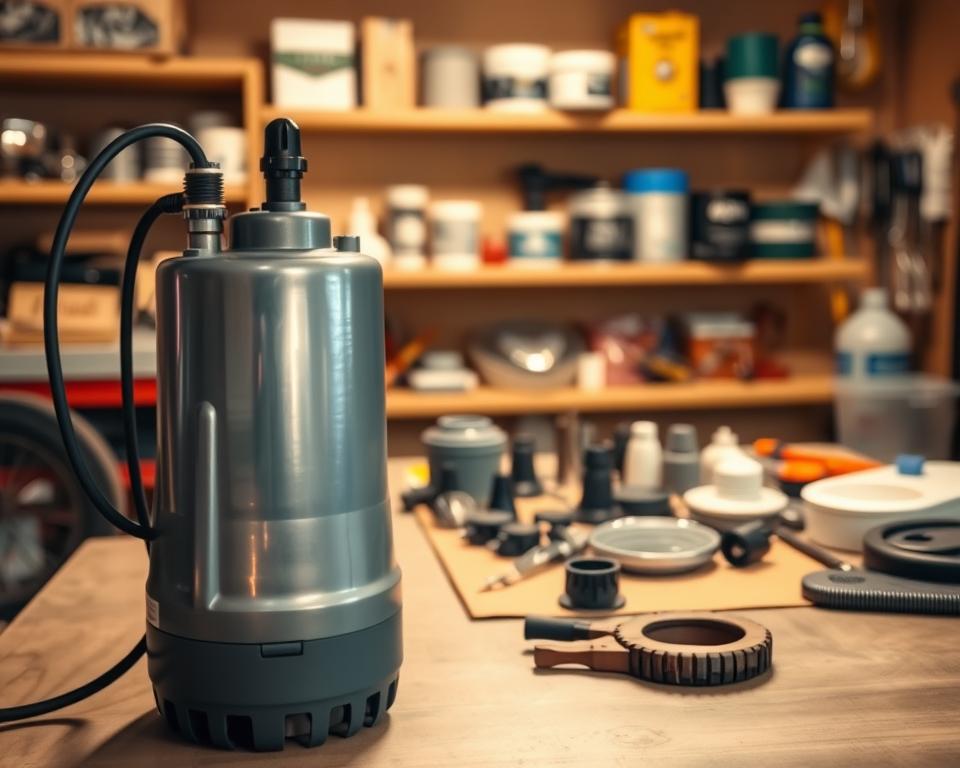Basement Septic Pump: Crucial Guide & Advice
Did you know over twenty-five percent of American homes use septic systems for waste management? This makes the basement septic pump crucial to keeping your home protected and dry. It moves effluent and excess water to the septic tank, especially in basements prone to water buildup. Knowing how these pumps work can save you time and costs.
Routine maintenance of your septic pump is crucial to prevent expensive repairs and keep it running well. In this guide, we’ll cover the basics of installing, maintaining, and replacing septic pumps. By the end, you’ll understand how to keep your basement dry and protect your home.
Grasping the Underground Septic Pump
The basement septic pump is key to handling wastewater in homes with a basement. It’s important to be aware of how it works to keep the system running efficiently and avoid problems.
What is an Underground Septic Pump?
A basement septic pump is a device made to move wastewater from the home’s lowest spot, usually the basement. It sits in a sump pit, which holds surplus sewage or water. This pump is vital for homes lower than the septic system’s level, making sure waste is pumped away properly.
How Does a Basement Septic Pump Work?
The pump works by a straightforward yet effective process. When wastewater fills the sump pit, a float switch notices the water level increasing. This triggers the septic tank pump to turn on, sending the wastewater to the local septic system. This automatic action is critical to prevent flooding and damage, keeping the home safe. Knowing how it works helps homeowners identify and fix problems early.
Choosing the Right Basement Septic Pump
Selecting the right emergency septic tank service near me is vital for homes with septic systems. It’s important to look at several features. These aspects ensure the pump matches your needs and the environment.
Key Aspects to Consider
When picking a basement pump for septic systems, think about these characteristics:
- HP: The pump’s capacity affects how much water it can handle.
- Model: Opt for between submersible and pedestal pumps based on space and water depth.
- Strength: Find pumps made of materials that don’t oxidize or wear out easily.
- Discharge Rate: Make sure the pump can displace enough water per minute for your home.
- Emergency Features: Think about pumps with battery backups for power outages.
Top Brands and Models Available
Many brands provide reliable pumps for different needs. Here are some top names:
| Brand | Model | Horsepower | Type | Unique Qualities |
|---|---|---|---|---|
| Zoeller | Model 98 | 0.5 HP | Submersible | Durable cast iron structure |
| Liberty Pumps | LE51A | 0.5 HP | Submersible | Effortless service access |
| Wayne | RTP50 | 0.5 HP | Pedestal | Rust-resistant materials |
Knowing key features and top brands helps homeowners pick the most suitable basement septic pump. This thoughtful choice boosts performance and minimizes problems. It ensures the pump works well for its entire life.
Basement Septic Pump Installation Guide
Installing a basement septic pump requires careful planning and knowing the key steps. Before starting, homeowners should review their basement’s layout for the most suitable spot. They must also look at the electrical and drainage systems nearby. Having the right tools and materials ready makes the installation more efficient.
Setup Steps for Installation
Here are the steps to prepare for a basement pump installation:
- Review local plumbing and building codes to confirm compliance.
- Assess your basement layout for the most suitable pump location.
- Ensure access to a reliable electrical source for pump operation.
- Gather required tools such as a drill, wrenches, and sealing materials.
- Read the manufacturer’s installation instructions in depth.
- If in doubt, think about consulting a professional for assistance on installation.
Effective planning is vital to successful septic pump maintenance after installation. These steps help prevent future problems and make the pump last longer. By being careful and conscientious, homeowners can get the most out of their new basement septic pump.
Maintaining Your Underground Septic Pump
Keeping your basement septic pump in good shape is vital to its durability and efficiency. Routine checks can detect small problems before they become big repairs. It’s important for homeowners to have a schedule that includes checking the pump and being aware of when it needs service.
Scheduled Maintenance Advice
- Inspect the sump pit regularly for debris that could block the pump.
- Test the pump’s work at least once a month to make sure it starts and off properly.
- Check electrical connections to keep the pump running properly.
- Clean the pump inlet and examine the float switch for any blockages.
- Monitor the quality of the effluent; bad smells or cloudy water could mean a bigger issue.
Signs That Your Pump Needs Service
Knowing when your basement septic pump needs fixing can prevent bigger issues later. Watch for these warning signs:
- Unusual noises from the pump, like grinding or rattling.
- The pump cycling more often than expected.
- Pump performance is sluggish, causing water to pool.
- Bad smells near the pump indicate it might not be working correctly.
Prompt response on these signs can help repair septic pump problems before they get worse. Routine maintenance, thorough checks, and prompt action can protect your home from water damage.
| Maintenance Activity | Interval | Reason |
|---|---|---|
| Inspect sump pit | Monthly | To eliminate debris and verify proper pump function |
| Test pump function | Every month | To ensure the pump turns on and stops correctly |
| Inspect electrical connections | Every three months | To prevent breakdowns in performance |
| Unclog pump inlet | Every year | To prevent clogs and ensure optimal water flow |
| Output quality check | Every year | To detect signs of contamination early |
When to Change Your Cellar Septic Pump
Being aware of when to replace your septic pump is crucial for keeping waste disposal systems working efficiently. You should think about replacing it if it’s over 10 years old. Also, if it’s not working efficiently, like cycling too much or not adequately, it’s time to consider replacing it.
Look out for signs of wear or damage, like leaks, loud noises, or if it won’t turn on. If your pump keeps becoming obstructed or has power issues, it’s wearing out faster. It’s advisable to consult with a pro to see if repairing it or getting a new one is better for your system.
| Factor | Indicator for Replacement |
|---|---|
| Age of Pump | Over 10 years |
| Functionality Problems | Constant or excessive cycling |
| Noticeable Wear | Leaks, cracks, or rust |
| Power Issues | Frequent failures after outages |
| Clogging | Frequent issues with blockage |
When deciding on replacing your septic pump, consider these signs. Taking action early keeps your home safe and your waste management system working right.
Common Issues with Basement Septic Pumps
Basement septic pumps are key to keeping waste management in order at home. Understanding common problems helps homeowners address them quickly. This can prevent bigger issues and help the system be more durable.
Comprehending and Resolving Problems
Basement septic pumps encounter many difficulties. The main issues include:
- Debris Obstructions: Materials caught can block the pump, halting waste from being removed.
- Motor Failure: The motor can fail over time, requiring a inspection and maybe a new one.
- Switch Issues: A faulty float switch can make the pump work improperly, not operate right.
Reviewing these parts regularly helps identify problems early. Homeowners can be alert to signs like unusual sounds or the pump running too much. This way, they can fix things fast.
| Trouble | Signs | Fixes |
|---|---|---|
| Clogging | Pump operates but does not discharge waste | Check and remove debris from pump intake |
| Motor Malfunction | Pump does not operate at all | Check power supply; change out motor if necessary |
| Switch Malfunctions | Pump runs without stopping or not at all | Check and change out faulty float switch |
Using a trusted service like All In Site Services ensures you get expert help for basement septic pump repairs. Quick action on problems keeps the system working smoothly. This keeps your home’s waste management system safe and dependable.
Conclusion
A basement septic pump is crucial for a home’s plumbing. It avoids water damage and sewage problems at bay by moving waste from the basement to the septic system. Being aware of how it works helps homeowners take care of their systems better.
Selecting the right septic tank pump is important for its longevity and efficient performance. Think about the pump type, size, and where it’s positioned. Routine upkeep and acting fast if there are problems will make your home safer.
Homeowners who look after their septic system protect their property and experience better living conditions. A working basement septic pump provides reassurance.



